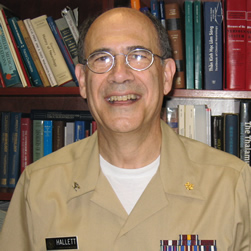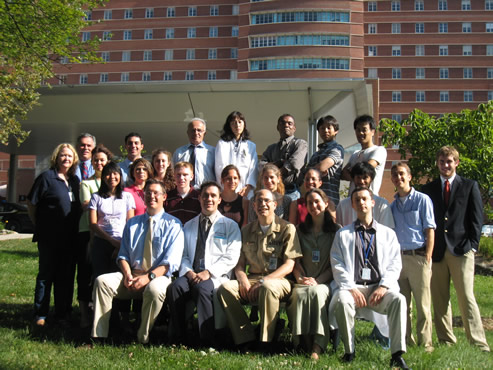|
|
 |
Back to Previous Page Previous Page
Human Motor Control Section

Mark Hallett, M.D., Senior Investigator
Dr. Hallett obtained his A.B. and M.D. at Harvard University, had his internship in Medicine at the Peter Bent Brigham Hospital and his Neurology training at Massachusetts General Hospital. He had fellowships in neurophysiology at the NIH and in the Department of Neurology, Institute of Psychiatry in London, where he worked with C. David Marsden. Before coming to NIH in 1984, Dr. Hallett was the Chief of the Clinical Neurophysiology Laboratory at the Brigham and Women's Hospital in Boston and Associate Professor of Neurology at Harvard Medical School. He is currently Chief of the Medical Neurology Branch and Chief of its Human Motor Control Section. He is now Editor-in-Chief of World Neurology, the newsletter of the World Federation of Neurology and Associate Editor of Brain. He has been President of the Movement Disorder Society and Vice-President of the American Academy of Neurology. Among many awards, in 2005 he won the Movement Disorder Research Award of the American Academy of Neurology and in 2007 he won the Wilhelm-Erb-GedenkmÜnze of the Deutsche Gesellschaft fÜr Neurologie. His research activities focus on the physiology of human voluntary movement and its
pathophysiology in disordered voluntary movement and involuntary movement.
 |  |
Staff:

- Muslimah Ali, B.A., Pre-doctoral IRTA alimu@ninds.nih.gov
- Kemal Bayulkem, M.D., Adjunct Investigator kemal.bayulkem@nih.gov
- Beth Belluscio, M.D., Clinical Fellow BelluscB@ninds.nih.gov
- David Benninger, M.D., Special Volunteer benningerd@ninds.nih.gov
- Brian Berman, M.D., Clinical Fellow bermanb2@ninds.nih.gov
- Claudia Bonin, Special Volunteer boninc@ninds.nih.gov
- Nancy Bowen, Dr.PH, M.P.H, Clinical Research Project Manager nancy_bowen@nih.gov
- Mae Brooks, Patient Care Coordinator mae.brooks@nih.gov
- Elaine Considine, R.N., Nurse considinee@ninds.nih.gov
- Anthony Crawley, Special Volunteer Anthony_crawley@nih.gov
- Nguyet Dang, Biomedical Engineer Nguyet.dang@nih.gov
- Aviva Ellenstein, M.D., Ph.D., Clinical Fellow ellensteina@ninds.nih.gov
- Celia Gallea, Ph.D., Research Fellow galleac@ninds.nih.gov
- Kisha Greene, Administrative Assistant kisha.greene@nih.gov
- Dietrich Haubenberger, M.D., Research Fellow haubenbergerd@ninds.nih.gov
- Priyantha Herath, M.D., Clinical Fellow herathp@ninds.nih.gov
- Silvina Horovitz, Ph.D., Staff Scientist horovits@ninds.nih.gov
- Elise Houdayer, Ph.D., Research Fellow houdayere@ninds.nih.gov
- Kazumi Iseki, M.D., Special Volunteer kazumi.iseki@nih.gov
- Seung-Hyun Jin, Ph.D., Research Fellow jinse@ninds.nih.gov
- Anke Karabanov, Special Volunteer anke.karabanov@nih.gov
- Barbara Kimber, Patient Care Coordinator kimberb@ninds.nih.gov
- Grisel Lopez, M.D., Staff Clinician glopez@mail.nih.gov
- Codrin Lungu, M.D., Clinical Fellow lunguci@ninds.nih.gov
- Enas Shahine, M.D., Research Fellow shahinee@mail.nih.gov
- Ejaz Shamim, M.D., Special Volunteer shamime@ninds.nih.gov
- Camilo Toro, M.D., Special Volunteer toroc@ninds.nih.gov
- Valerie Voon, M.D., Clinical Fellow voonv@ninds.nih.gov
- Sherry Vorbach, Laboratory Technician sherry.vorbach@nih.gov
- Toshiaki Wasaka, Ph.D., Special Volunteer wasakat@ninds.nih.gov
- Kimberly A. Witherspoon, Program Specialist withersk1@mail.nih.gov
 |  |
Research Interests:
The general mission of the Human Motor Control Section is to understand the physiology of normal human voluntary movement and the pathophysiology of different movement disorders. The members of the Section work together on the different projects, each bringing special expertise to the tasks. The main techniques employed are transcranial magnetic stimulation (TMS), electroencephalography (EEG), neuroimaging with positron emission tomography (PET) and functional magnetic resonance imaging (fMRI), and other techniques of clinical neurophysiology. The principal diseases studied are dystonia, Parkinson's disease, cerebellar ataxia, myoclonus, essential tremor, tic, psychogenic movement disorders and startle disorders.
In relation to the physiology of movement, we have studied the brain processes associated with the preparation and execution of different types of movements. A special interest now is the process of movement initiation and volition. We have been studying motor learning including the process of making movement automatic.
Dystonia has been the main movement disorder investigated recently. We have found that there are a number of pathophysiological problems including loss of surround inhibition, abnormal plasticity and defective sensory function. We are looking further into the mechanisms of these problems. We have been studying the genesis of tics in patients with Tourette Syndrome. Part of our work is to translate physiological insights into therapies, and we have clinical trials ongoing in Parkinson's disease, dystonia and essential tremor.
Clinical Protocols:
- Physiology of weakness with movement disorders 06-N-0125
- Phenotype/Genotype Correlations in Movement Disorders 01-N-0206
- Treatment for Psychogenic Movement Disorders 06-N-0139
- Long-Term Motor Learning in Focal Hand Dystonia 06-N-0161
- Impaired motor learning and LTP/LTD-like plasticity in dystonia, are associated with abnormal modulation of cortical excitability by somatosensory volleys 05-N-0094
- Placebo Controlled Study of the Therapeutic Effect of the Transcranial Electrical Polarization in Patients with Focal Hand Dystonia 05-N-0122
- The role of cortical coherence in focal hand dystonia 05-N-0228
- In Vivo Mapping of Structural and Biochemical Brain Abnormalities in Patients with Primary Focal Dystonia 02-N-0132
- Transcranial Electrical Polarization for the Treatment of Bradykinesia and Rigidity in Patients with Parkinson's Disease. 03-N-0116
- Brain Networks Responsible for Sense of Agency: An EEG study 06-N-0084
Selected Publications:
- Tamura Y, Matsuhashi M, Lin P, Ou B, Vorbach S, Kakigi R, Hallett M. (2008) Impaired intracortical inhibition in the primary somatosensory cortex in focal hand dystonia., Mov Disord. 15;23(4), 558-65.
- Hallett M. (2007) Volitional control of movement: the physiology of free will., Clin Neurophysiol Jun;118(6), 1179-92.
- Defazio G, Berardelli A, Hallett M. (2007) Do primary adult-onset focal dystonias share aetiological factors?, Brain May;130(Pt 5), 1183-93.
- Hallett M. (2007) Transcranial Magnetic Stimulation: A Primer, Neuron Jul 19;55(2), 187-199.
- Fridman EA, Immisch I, Hanakawa T, Bohlhalter S, Waldvogel D, Kansaku K,Wheaton L, Wu T, Hallett M (2006) The role of the dorsal stream for gesture, Neuroimage 29, 417-428. Full Text/Abstract
- Bohlhalter S, Goldfine A, Matteson S, Garraux G, Hanakawa T, Kansaku K, Wurzman R, Hallett M (2006) Neural correlates of tic generation in Tourette syndrome: an event-related functional MRI study, Brain Aug;129(Pt 8), 2029-37. Full Text/Abstract
- Lomarev MP, Kanchana S, Bara-Jimenez W, Iyer M, Wassermann EM, Hallett M. (2006) Placebo-controlled study of rTMS for the treatment of Parkinson's disease, Movement Disorders 21, 325-331. Full Text/Abstract
All Selected Publications
Contact Information:
Dr. Mark Hallett
Human Motor Control Section
Medical Neurology Branch, NINDS
NIH, Building 10, Room 7D37
10 Center Drive, MSC 1428
Bethesda, MD 20892-1428
Telephone: 301-496-9526 office,
301-496-9526 laboratory,
301-480-2286 fax
Email: hallettm@ninds.nih.gov
|

